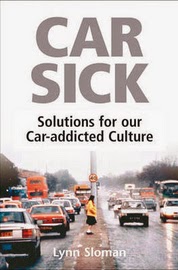 Staff Review by Chris Saliba
Staff Review by Chris SalibaIn this inspiring and impressively researched book, Lynn Sloman shows how traffic congestion could be dramatically cut. She convincingly demonstrates that cars are expensive, wasteful and not necessarily faster than other transport options.
Author and sustainable transport consultant Lynn Sloman brings her passion for walking, cycling and public transport to this smart and practical book, Car Sick. She believes that car traffic could be dramatically cut, anywhere up to 80 percent, by a mixture of improved public transport, information campaigns, cycleways and the creation of more attractive public places. In one study she cites, suburban shopping strips actually attracted increased trade once car parking was banned, despite retailers fearing they would lose significant business.
The popular solution today to fixing up road congestion is the building of more roads. Sloman cites a comprehensive 1970s study of the Westway elevated motorway in West London. It found that once the Westway was built, traffic flows increased 79% between 1970-1975, until it was fully clogged with traffic and couldn't grow any further. She says that authorities were mystified as to where all the extra cars were coming from. It seemed the only explanation was that people were now taking extra trips that they usually wouldn't, or finding jobs further away from home. The basic lesson of building extra roads is if you build it, they will come. The building of a new roads is simply an invitation for more people to avoid walking, public transport and cycling, opting to drive instead.
The most amazing findings of Car Sick are the amount of car trips that could be cut. After reviewing the research, Sloman grouped car trips into three different types. She found 40 percent of trips could be easily done by other means (foot, bike or public transport), but that car drivers lacked knowledge of alternatives. Another 40 percent could be cut by improving public transport and other options. The last twenty percent of trips she found to be immovable. These are the sort of trips that are unavoidable, for example taking a sick family member to the hospital or when you need to move something heavy.
I know that the car driving reader is probably groaning by this stage: if I catch public transport, it will take an hour longer. Again, the research provides some interesting counterpoints. It appears that when considering public transport, commuters are more pessimistic about how long a journey will take. Whereas when contemplating car use, drivers are overly optimistic. They think they will get to a destination quicker, but they don't. The reason for this optimism, it is speculated, is the nature of glossy car advertising: freewheeling car trips along gorgeous country roads and no traffic congestion in sight.
Sloman discusses research by Werner Brog, who conducted surveys in the UK city of Darlington.
“He found that on average, people overestimated the public transport journey time by 70 per cent, so that, for example, they assume a 20-minute trip would actually take 34 minutes. They underestimated the journey time by car by 26 percent, assuming a 20-minute trip would actually take 15 minutes. In another survey, this time in Germany, he found the same car-bias in people's perceptions of the cost of travel. People over estimated the cost of public transport travel by 21 percent, and underestimated the the true cost of car travel by 58 percent.”
Sloman has done extensive work with local councils and government, and her personal insights into transport planning are revealing. She says that transport ministers are invariably male and are attracted to big projects that make them look important (cycle paths don't fit the bill for this). She says how hard it is to get ministers to look at the research and think of alternatives to cars. Male urban planners see cars and roads as the only solution to transport problems.
For Australians, who are stuck in so much gridlock, Lynn Sloman's useful book points the way to reducing traffic, creating safer places for pedestrians and healthier lives through cycling and walking. It sounds overly optimistic to say we could cut traffic by some 80 percent. Even though I am biased in favour of walking and cycling, I believe Lynn Sloman has demonstrated proven ways to get people out of their cars. This is a book our transport planners should study.
Car Sick: Solutions for Our Car-Addicted Culture, by Lyn Sloman. Published by Green Books. ISBN: 9781903998762 $26.95
To sign up for our monthly newsletter, featuring new releases, book reviews and favourite articles from around the web, click here.
No comments:
Post a Comment